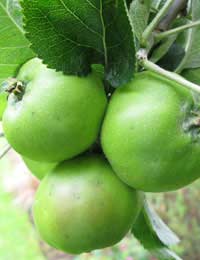
Preserving apples and other hard fruit is a great way to extend the season. Here are some recipe ideas for preserving apples, pears and hedgerow fruit.
Preserving Apples
Here are some ideas for preserving your apple glut:
Preserving Pears
In her Fruit Book, along with plenty of pudding recipes, Jane Grigson describes a method for pickling pears – “to serve with ham or cold pork”. After poaching sliced pears briefly in boiling water, she cooks them in a solution of white wine vinegar (1 cup) and sugar (2 cups) with a teaspoon each of cloves, allspice and cinnamon. The pears are lifted out, cooled, and packed into sterilised jars; finally the vinegar solution is reduced to a syrup and poured over the pears.
She also gives away the secret to Williams’ Pear Liqueur – an old-fashioned spirit that was sold with a large pear inside the bottle. When small fruits set on the pear tree, growers would push a glass bottle around them, sealing the end with tape and supporting the bottle using canes. The fruit swells and ripens inside the glass, and then growers would cut the branch and use the bottled pear as the basis for fruit schnapps. To preserve a pear in this way, you would fill the bottle with vodka, seal, and (traditionally) leave in the sun for another month. At this point, sugar is added, and the bottle re-sealed until ready.
Preserving Hedgerow Fruits: ideas and recipes
Elderberries, which are usually ripe in late August, make an interesting fruit vinegar. Gather the berries by snipping whole heads into a bag. Shake to get rid of insects, then use a fork to pull the berries from the stems. Wash and dry 6 cups of fruit, then crush it lightly. Put into a large bowl or clean bucket, and cover the fruit with 2 pints of red wine vinegar. After three days, strain the vinegar through a muslin bag (or sieve if that’s all you have) and measure the clear vinegar. Add one cup of caster sugar for each pint, and put it all into a large saucepan. Simmer for ten minutes, then pour into sterilised bottles.
Crab apples and rosehips make good jellies to eat on toast or dolloped onto pancakes. As well as the usual preserving equipment you’ll need a jelly bag – a muslin bag that can be suspended from a frame until the fruit puree has dripped through it. Jelly is made by simmering the fruit until soft and pulpy, passing it through the jelly bag, and finally adding sugar to the juice and returning to the pan to boil until set.
Basic Apple Jelly Recipe
This recipe can be adapted to use pears or crab apples, or a combination of brambles, elderflowers or elderberries with apples.
Weigh your unprepared apples and add water in the ratio 2:3 (200ml water:300g fruit). Cut out any bruises and chop large apples, then put into a pan and bring gently to a simmer. Stir occasionally until the fruit is perfectly soft and giving up its juice. Now strain using a jelly bag, and measure the resulting juice. Add 2 cups of caster sugar to every pint of juice, and return to the cleaned-out saucepan. Simmer gently until setting point has reached (see our article on jam) and spoon into sterilised jars.
